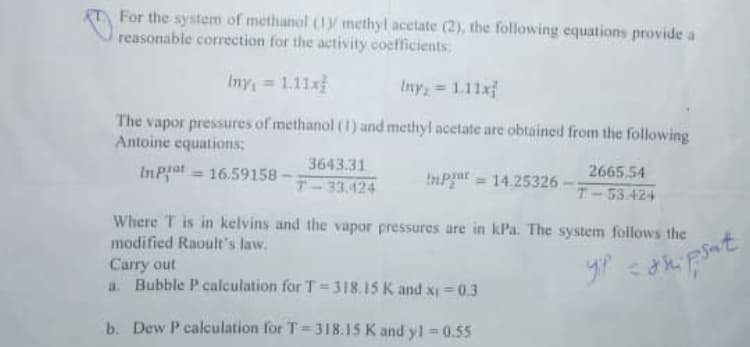For the system of methanol (1y methyl acetate (2), the following equations provide a reasonable correction for the activity coefficients Iny = 1.11x Iny = 1.11xf The vapor pressures of methanol ((1) and methyl acetate are obtained from the following Antoine equations; 3643.31 InPat = 16.59158 InPat = 14.25326 2665,54 %3D T-33.424 T-53.424 Where T is in kelvins and the vapor pressures are in kPa. The system follows the modified Raoult's law. Carry out a. Bubble P calculation for T=318.15 K and xI = 0.3 b. Dew P calculation for T=318.15 K and y1=0.55
For the system of methanol (1y methyl acetate (2), the following equations provide a reasonable correction for the activity coefficients Iny = 1.11x Iny = 1.11xf The vapor pressures of methanol ((1) and methyl acetate are obtained from the following Antoine equations; 3643.31 InPat = 16.59158 InPat = 14.25326 2665,54 %3D T-33.424 T-53.424 Where T is in kelvins and the vapor pressures are in kPa. The system follows the modified Raoult's law. Carry out a. Bubble P calculation for T=318.15 K and xI = 0.3 b. Dew P calculation for T=318.15 K and y1=0.55
Introduction to Chemical Engineering Thermodynamics
8th Edition
ISBN:9781259696527
Author:J.M. Smith Termodinamica en ingenieria quimica, Hendrick C Van Ness, Michael Abbott, Mark Swihart
Publisher:J.M. Smith Termodinamica en ingenieria quimica, Hendrick C Van Ness, Michael Abbott, Mark Swihart
Chapter1: Introduction
Section: Chapter Questions
Problem 1.1P
Related questions
Question

Transcribed Image Text:For the system of methanol (1y methyl acetate (2), the following equations provide a
reasonable correction for the activity coefficients
Iny = 1.11x
Iny = 1.11xf
The vapor pressures of methanol ((1) and methyl acetate are obtained from the following
Antoine equations;
3643.31
InPat = 16.59158
InPat = 14.25326
2665,54
%3D
T-33.424
T-53.424
Where T is in kelvins and the vapor pressures are in kPa. The system follows the
modified Raoult's law.
Carry out
a. Bubble P calculation for T=318.15 K and xI = 0.3
b. Dew P calculation for T=318.15 K and y1=0.55
Expert Solution
Trending now
This is a popular solution!
Step by step
Solved in 10 steps with 7 images

Knowledge Booster
Learn more about
Need a deep-dive on the concept behind this application? Look no further. Learn more about this topic, chemical-engineering and related others by exploring similar questions and additional content below.Recommended textbooks for you

Introduction to Chemical Engineering Thermodynami…
Chemical Engineering
ISBN:
9781259696527
Author:
J.M. Smith Termodinamica en ingenieria quimica, Hendrick C Van Ness, Michael Abbott, Mark Swihart
Publisher:
McGraw-Hill Education

Elementary Principles of Chemical Processes, Bind…
Chemical Engineering
ISBN:
9781118431221
Author:
Richard M. Felder, Ronald W. Rousseau, Lisa G. Bullard
Publisher:
WILEY

Elements of Chemical Reaction Engineering (5th Ed…
Chemical Engineering
ISBN:
9780133887518
Author:
H. Scott Fogler
Publisher:
Prentice Hall

Introduction to Chemical Engineering Thermodynami…
Chemical Engineering
ISBN:
9781259696527
Author:
J.M. Smith Termodinamica en ingenieria quimica, Hendrick C Van Ness, Michael Abbott, Mark Swihart
Publisher:
McGraw-Hill Education

Elementary Principles of Chemical Processes, Bind…
Chemical Engineering
ISBN:
9781118431221
Author:
Richard M. Felder, Ronald W. Rousseau, Lisa G. Bullard
Publisher:
WILEY

Elements of Chemical Reaction Engineering (5th Ed…
Chemical Engineering
ISBN:
9780133887518
Author:
H. Scott Fogler
Publisher:
Prentice Hall


Industrial Plastics: Theory and Applications
Chemical Engineering
ISBN:
9781285061238
Author:
Lokensgard, Erik
Publisher:
Delmar Cengage Learning

Unit Operations of Chemical Engineering
Chemical Engineering
ISBN:
9780072848236
Author:
Warren McCabe, Julian C. Smith, Peter Harriott
Publisher:
McGraw-Hill Companies, The